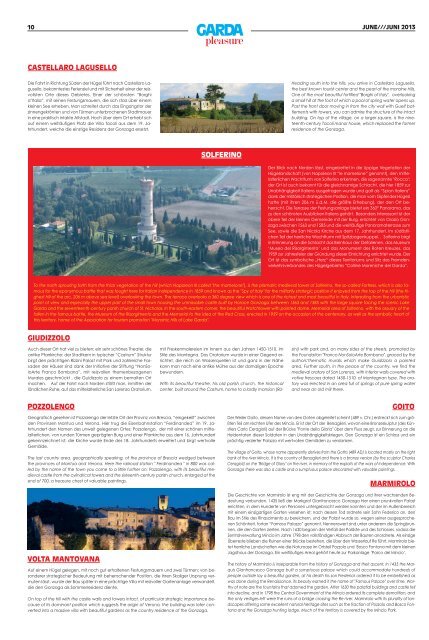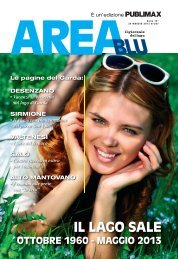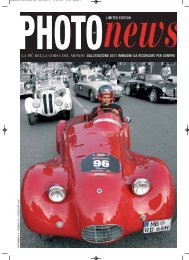Garda Pleasure giugno 2013 8:Layout 1 - Publimax
Garda Pleasure giugno 2013 8:Layout 1 - Publimax
Garda Pleasure giugno 2013 8:Layout 1 - Publimax
Sie wollen auch ein ePaper? Erhöhen Sie die Reichweite Ihrer Titel.
YUMPU macht aus Druck-PDFs automatisch weboptimierte ePaper, die Google liebt.
10 JUNE///JUNI <strong>2013</strong><br />
GARDA<br />
pleasure<br />
CASTELLARO LAGUSELLO<br />
Die Fahrt in Richtung Süden der Hügel führt nach Castellaro Lagusello,<br />
bekanntestes Ferienziel und mit Sicherheit einer der reizvollsten<br />
Orte dieses Gebietes. Einer der schönsten “Borghi<br />
d’Italia”, mit seinen Festungsmauern, die sich stolz über einem<br />
kleinen See erheben. Man schreitet durch das Eingangstor der<br />
zinnengekrönten und von Türmen unterbrochenen Stadtmauer<br />
in eine praktisch intakte Altstadt. Hoch über dem Ort erhebt sich<br />
auf einem weitläufigen Platz die Villa Tacoli aus dem 19. Jahrhundert,<br />
welche die einstige Residenz der Gonzaga ersetzt.<br />
Heading south into the hills, you arrive in Castellaro Lagusello,<br />
the best known tourist center and the pearl of the moraine hills.<br />
One of the most beautiful fortified "Borghi of Italy", overlooking<br />
a small hill at the foot of which a pool of spring water opens up.<br />
Past the front door moving in from the city wall with Guelf battlements<br />
with towers, you can admire the structure of the intact<br />
building. On top of the village, on a larger square, is the nineteenth-century<br />
Tacoli manor house, which replaced the former<br />
residence of the Gonzaga.<br />
SOLFERINO<br />
Der Blick nach Norden lässt, eingebettet in die üppige Vegetation der<br />
Hügellandschaft (von Napoleon III “le mamelone” genannt), den mittelalterlichen<br />
Wachtturm von Solferino erkennen, die sogenannte ‘Rocca’;<br />
der Ort ist auch bekannt für die gleichnamige Schlacht, die hier 1859 zur<br />
Unabhängigkeit Italiens ausgetragen wurde und galt als “Spion Italiens”<br />
dank der militärisch strategischen Position, die man vom Gipfel des Hügels<br />
hatte (mit ihren 206 m ü.d.M. die größte Erhebung), der den Ort beherrscht.<br />
Die Terrasse der Festungsanlage bietet ein 360° Panorama, das<br />
zu den schönsten Ausblicken Italiens gehört. Besonders interessant ist der<br />
obere Teil der kleinen Gemeinde mit der Burg, errichtet von Orazio Gonzaga<br />
zwischen 1563 und 1585 und die weitläufige Panoramaterrasse zum<br />
See, sowie die San Nicola Kirche aus dem 17. Jahrhundert. Im südöstlichen<br />
Teil der herrliche Wachtturm mit Spitzbogenkuppel. . Solferino birgt<br />
in Erinnerung an die Schlacht das Beinhaus der Gefallenen, das Museum<br />
‘Museo del Risorgimento’ und das Monument des Roten Kreuzes, das<br />
1959 zur Jahresfeier der Gründung dieser Einrichtung errichtet wurde. Der<br />
Ort ist das symbolische „Herz“ dieses Territoriums und Sitz des Fremdenverkehrsverbandes<br />
des Hügelgebietes “Colline Moreniche del <strong>Garda</strong>”.<br />
To the north sprouting forth from the thick vegetation of the hill (which Napoleon III called "the mamelone"), is the prismatic medieval tower of Solferino, the so-called Fortress, which is also famous<br />
for the eponymous battle that was fought here for Italian independence in 1859 and known as the "Spy of Italy" for the militarily strategic position it enjoyed from the top of the hill (the highest<br />
hill of the arc, 206 m above sea level) overlooking the town. The terrace overlooks a 360 degree view which is one of the richest and most beautiful in Italy. Interesting from the urbanistic<br />
point of view and especially the upper part of the small town housing the unmissable castle built by Horace Gonzaga between 1563 and 1585 with the large square facing the scenic Lake<br />
<strong>Garda</strong> and the seventeenth-century parish church of St. Nicholas. In the south-eastern corner, the beautiful Watchtower with pointed dome. Memorial area of Solferino, with the ossuary of the<br />
fallen in the famous battle, the Museum of the Risorgimento and the Memorial to the Idea of the Red Cross, erected in 1959 on the occasion of the centenary, as well as the symbolic heart of<br />
this territory, home of the Association for tourism promotion "Morainic hills of Lake <strong>Garda</strong>".<br />
GIUDIZZOLO<br />
Auch dieser Ort hat viel zu bieten: ein sehr schönes Theater, die<br />
antike Pfarrkirche; der Stadtkern in typischer “Castrum” Struktur<br />
birgt den prächtigen Rizzini Palast mit Park und zahlreiche Fassaden<br />
der Häuser sind dank der Initiative der Stiftung “NonSoloArte<br />
Franco Bombana”, mit reizvollen themenbezogenen<br />
Murales geschmückt , die Guidizzolo zu einem bemalten Ort<br />
machen. Auf der Fahrt nach Norden stößt man, inmitten der<br />
ländlichen Ruhe, auf das mittelalterliche San Lorenzo Oratorium,<br />
mit Freskenmalereien im Innern aus den Jahren 1450-1510, im<br />
Stile des Mantegna. Das Oratorium wurde in einer Gegend errichtet,<br />
die reich an Wasserquellen ist und ganz in der Nähe<br />
kann man noch eine antike Mühle aus der damaligen Epoche<br />
bewundern.<br />
With its beautiful theatre, his old parish church, the historical<br />
center, built around the Castrum, home to a lordly mansion (Rizzini)<br />
with park and, on many sides of the streets, promoted by<br />
the Foundation "Franco NonSoloArte Bombana", graced by the<br />
authors’thematic murals which make Guidizzolo a painted<br />
area. Further south, in the peace of the country, we find the<br />
medieval oratory of San Lorenzo, with interior walls covered with<br />
votive frescoes dated 1450-1510, of Mantegnan type. The oratory<br />
was erected in an area full of springs of pure spring water<br />
and near an old mill there.<br />
POZZOLENGO<br />
GOITO<br />
Geografisch gesehen ist Pozzolengo der letzte Ort der Provinz von Brescia, “eingekeilt” zwischen<br />
den Provinzen Mantua und Verona. Hier trug die Eisenbahnstation “Ferdinandea” im 19. Jahrhundert<br />
den Namen des unweit gelegenen Ortes: Pozzolengo, der mit einer schönen mittelalterlichen,<br />
von runden Türmen geprägten Burg und einer Pfarrkirche aus dem 16. Jahrhundert<br />
gekennzeichnet ist; die Kirche wurde Ende des 18. Jahrhunderts erweitert und birgt wertvolle<br />
Gemälde.<br />
The last country area, geographically speaking, of the province of Brescia wedged between<br />
the provinces of Mantua and Verona. Here the railroad station " Ferdinandea " in 800 was called<br />
by the name of the town you come to a little further on: Pozzolengo, with its beautiful medieval<br />
castle from the cylindrical towers and the sixteenth-century parish church, enlarged at the<br />
end of 700, a treasure chest of valuable paintings.<br />
VOLTA MANTOVANA<br />
Auf einem Hügel gelegen, mit noch gut erhaltenen Festungsmauern und zwei Türmen; von besonderer<br />
strategischer Bedeutung mit beherrschender Position, die ihren Skaliger Ursprung vermuten<br />
lässt, wurde der Bau später in eine prächtige Villa mit reizvoller Gartenanlage verwandelt,<br />
die den Gonzaga als Sommerresidenz diente.<br />
On top of the hill with the castle walls and towers intact, of particular strategic importance because<br />
of its dominant position which suggests the origin of Verona, the building was later converted<br />
into a massive villa with beautiful gardens as the country residence of the Gonzaga.<br />
Der Weiler Goito, dessen Name von den Goten abgeleitet scheint (489 v. Chr.) erstreckt sich zum größten<br />
Teil am rechten Ufer des Mincio. Er ist der Ort der Bersaglieri, wovon eine Bronzeskulptur (des Künstlers<br />
Carlo Ceragioli) auf der Brücke "Ponte della Gloria" über dem Fluss zeugt, zur Erinnerung an die<br />
Heldentaten dieser Soldaten in den Unabhängigkeitskriegen. Den Gonzaga ist ein Schloss und ein<br />
prächtig verzierter Palazzo mit wertvollen Gemälden zu verdanken.<br />
The village of Goito, whose name apparently derives from the Goths (489 AD) is located mostly on the right<br />
bank of the river Mincio. It is the country of Bersaglieri and there is a bronze version (by the sculptor Charles<br />
Ceragioli) on the "Bridge of Glory" on the river, in memory of the exploits of the wars of independence. With<br />
Gonzaga there was also a castle and a sumptuous palace decorated with valuable paintings.<br />
MARMIROLO<br />
Die Geschichte von Marmirolo ist eng mit der Geschichte der Gonzaga und ihrer wachsenden Bedeutung<br />
verbunden. 1435 ließ der Markgraf Gianfrancesco Gonzaga hier einen prunkvollen Palast<br />
errichten, in dem Hunderte von Personen untergebracht werden konnten und der im Außenbereich<br />
mit einem einzigartigen Garten versehen ist; nach dessen Tod ordnete sein Sohn Federico an, den<br />
Bau im Stile des Rinascimento zu bereichern, und der Palast wurde so, wegen seiner ausgesprochenen<br />
Schönheit, fortan “Famoso Palazzo” genannt. Nennenswert sind unter anderem die Springbrunnen,<br />
die den Garten zierten. Nach 1630 begann der Verfall der Paläste und des Schlosses, sodass die<br />
Zentralverwaltung Mincio im Jahre 1798 den vollständigen Abbruch der Bauten anordnete. Als einzige<br />
Überreste blieben die Ruinen einer Brücke bestehen, die über den Wasserlauf Re führt. Marmirolo bietet<br />
herrliche Landschaften wie die Naturoase im Ortsteil Pozzolo und Bosco Fontana mit dem kleinen<br />
Jagdhaus der Gonzaga. Ein weitläufiges Areal gehört heute zur Parkanlage ‘Parco del Mincio‘.<br />
The history of Marmirolo is inseparable from the history of Gonzaga and their ascent. In 1435 the Marquis<br />
Gianfrancesco Gonzaga built a sumptuous palace which could accommodate hundreds of<br />
people outside lay a beautiful garden, at his death his son Frederick ordered it to be embellished as<br />
was done during the Renaissance, its beauty earned it the name of "Famous Palace" over time. Worthy<br />
of note are the fountains that adorned the garden. After 1630 the palatial buildings and castle fell<br />
into decline, and in 1798 the Central Government of the Mincio ordered its complete demolition, and<br />
the only vestiges left were the ruins of a bridge crossing the Re river. Marmirolo with its plurality of landscapes<br />
offering some excellent natural heritage sites such as the fraction of Pozzolo and Bosco Fontana<br />
and the Gonzaga hunting lodge. Much of the territory is covered by the Mincio Park.









